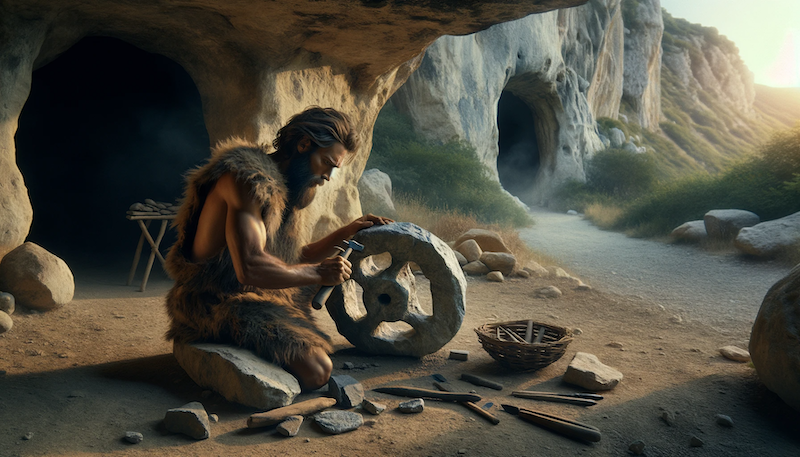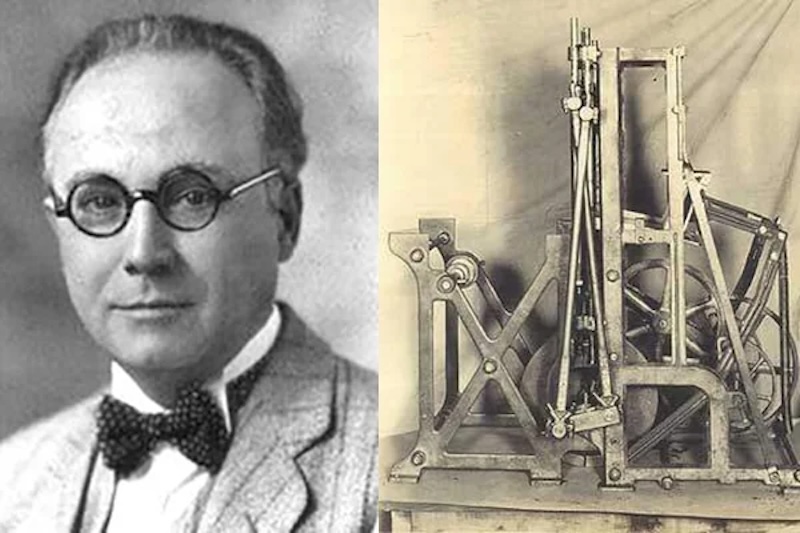Check out the innovative video for this innovative issue
If you’re anything like me, you’ve been misled your entire life. Let me explain how.
It starts with fire and the wheel.
I know that cavemen discovered how to harness fire about 1 million years ago. It was a big discovery, of course. I’m sure there was a caveman party or some sort of celebratory shindig.
Medium rare mastodon meat for all my friends!
Fast forward a generation or two later, and I envision a caveman dressed in the latest Fred Flinstone fashion, sitting in his cave on a nice autumn day as he chiseled away on a stone. Suddenly – whamo – he discovered the wheel.

Why the cave people needed a wheel a million years ago is probably a good question, but I’m not interested in logic right now.
Fire was harnessed and then the wheel was invented shortly thereafter.
Are you with me on this so far?
Imagine my surprise when I learned that the wheel was not invented by cavemen 1 million years ago. Actually, it came into existence in 3500 BC, a mere 5,000-ish years ago. Which feels about how long it’s taken me to write this article.
Keep in mind that the world was already pretty advanced by 3500 BC.
Urban planning and irrigation systems were already in existence. The Egyptians had already been constructing pyramids for at least 1,000 years by then. And people had already been building boats and sailing in them for 5,000 years.
What I’m saying is that civilization went through a heckuva lot of other innovations before it found time to get to the wheel.
Oh, and when the wheel was invented, it wasn’t even used for transportation. It was used for pottery.
It took another 500 years (until 3000 BC) before some brilliant person figured out that you could put the pottery wheel on its side and attach it to a cart.
Be honest with me…did you also think the wheel was invented by cavemen? Is it just me?
Now imagine my surprise when I learned about sliced bread.

The Best Innovation Since Sliced Bread
It always seemed logical to me for the Romans to have invented sliced bread. After all, they invented practically everything else that has to do with a civilized society.
They are the ones who brought us such groundbreaking ideas as highways, sanitation systems, concrete, and, yes, even central heating. It’s like they built Los Angeles 2000 years before Los Angeles was built.
By the way, if you can create central heating back in 80 AD, surely you can create sliced bread, right?
Wrong.
Sliced bread wasn’t created by a Roman Emperor in 80 AD, it was created by a guy named Otto from Davenport, Iowa in 1928.
Otto Rohwedder is his name, in case you were wondering. He was a jeweler who came up with the idea for sliced bread while standing mindlessly in the shower thinking about life, as we all tend to do.
[Editor’s Note: Motion to strike the shower part of the story. Irrelevant and unconfirmed]
In a bold move, Otto decided to sell all of his jewelry stores to focus full-time on bringing his idea to fruition. It took a few years but, in 1928, his magic machine was released and his patents came to life.
Sliced bread.
The idea of sliced bread spread pretty darn fast.
Otto’s invention in 1928 grew so quickly, that the Wonder Bread folks, who had been selling whole loaves of bread since 1921, realized they needed to make changes.
In 1930, just two years after Otto brought the concept to the world, Wonder Bread started pre-slicing their bread. By 1933, 80% of all the bread sold in the US was pre-sliced.
Keep in mind that this mass adoption was before much communication technology. Sliced bread reached ubiquitousness within only 5 years, which is faster than the growth of almost every other major invention since 1903.
So now I ask you, how could it have taken until 1928 to invent sliced bread?
Trust me, I’ve got a point to all this, and my point is innovation.

My Point Is Innovation, But I Said That Already
Innovation is everything.
Well, maybe not everything, but it’s really important.
Innovation drives growth – individually and universally.
Sometimes it’s good growth and sometimes it’s bad growth, but it’s growth nonetheless.
Let’s not forget my two main questions:
- Why did it take a million years for the wheel to be invented?
- Why did it take until 1928, and a dude named Otto, to invent sliced bread?
The answers lie in the reasons for innovation. And the reasons for innovation are critical components in understanding how to grow your business and your career.
As it turns out, there are three reasons for innovation. Here they are:
- To avoid a catastrophe
- To better solve a problem
- To help others
Let’s talk about these for a minute and then we’ll get to you.

1. Innovation To Avoid Catastrophe
Priority Level: Very High
Team Commitment: Very High
Who Leads The Charge: Senior Management
Speed To Market: Usually fast
Most of the most impactful innovations haven’t happened in times of happy-go-luckyness. Impactful innovation happens when somebody’s proverbial foot is standing on your proverbial throat.
Spears were invented so the human race could survive.
Radar was created to stop military personnel from being killed.
Satellite technology was advanced to avoid a nuclear holocaust.
And a COVID vaccine was whipped together to avoid a full economic collapse.
Few things rally a team to innovate well together as does a potential catastrophe.
Innovations that help avoid catastrophes will (and should) always be prioritized above any other innovations. And this is why neither the wheel nor sliced bread were anywhere in anybody’s thinking for a long long time.

2. Innovation To Better Solve A Problem
Priority Level: Low to High
Team Commitment: Low to High
Who Leads The Charge: The person with the most to gain
Speed To Market: Never as fast as you want it to be
The vast majority of innovations are created to better solve a problem.
Sometimes the problem that needs a better solution is known to the people involved. These are the problems that are solved by the people you take for granted.
- It’s the client support person that comes up with a new way to assess customer satisfaction
- It’s the warehouse worker re-organizes to increase efficiency and productivity
However, sometimes the problem that needs a better solution isn’t obvious to everybody.
- Yahoo! seemed like a good enough search engine back in the day. But when Google launched, we realized we did, in fact, need a better way to search.
- Watching TV when the shows were on seemed good enough for decades. But when TiVo and DVRs were invented, we realized we did, in fact, need a better way to watch TV.
And, most importantly, riding on horses seemed to work out well for everyone, but when the wheel was invented for transportation, we realized we did, in fact, need a better way to move things.
It didn’t take a catastrophe to invent the wheel, it took a few people who thought of a problem and tried to solve it in a better way.
So what about sliced bread?
That brings us to the third type of innovation.

3. Innovation To Help Others
Priority Level: Low
Team Commitment: Low to Medium
Who Leads The Charge: Usually one person
Speed To Market: Slow
I like to think that we are a benevolent society that wants to help each other. We’re not. Or, rather, it’s not the driving force for innovation.
The biggest innovations emerge from catastrophes.
Then comes the innovations to create better ways to solve problems.
And if there is any energy left at the end of the day, the slowest, least prioritized innovations are simply done for good.
They are simply created to benefit other people.
Most of these types of innovations are not driven by a team, but by one person with a mission.
Take sliced bread as an example.
- The reason nobody else invented slice bread in the previous million years was because nobody needed it.
- Similarly, chefs innovate with food preparation simply because they think people will enjoy the taste.
- Artists create new things simply because they think it will resonate with others.
And this is the part where we boomerang it all back to you.

Innovation Is Growth
As I said above, which you’d remember had your eyes not glazed over, innovation is critical to growth. Both in your company and in your career.
In order for your company to grow, your company must innovate. In order for your career to grow, you must innovate.
In my role as a business consultant, I hear many people complain about their company’s lack of innovation.
Here is the important thing to understand, so open up your eyes and perk up those ears:
Every single person in a company is responsible for innovation. If you’re the one who embraces that innovation, your career will grow.
That’s right. Your company needs innovation to grow, and if you help drive that innovation, YOU will grow.
In the words of the great prophet, Steve Jobs,
Innovation distinguishes between a leader and a follower.
So be a leader.
The Opportunities For Innovation
Opportunities for innovation are everywhere, you just have to look for them.
You don’t need to be in the C-Suite to learn the 7 secrets for a culture of calculated risks, you just need to start seeing the problems and proactively overcoming them.
So it’s about that time to stop wondering why it took so long to create the wheel or slice the bread, the power of innovation is in your hands.
Embrace your inner Otto Rohwedder. There is nothing stopping you from changing the world except for your unwillingness to do it.
Begin to innovate your life now.
I promise, only good will come out of it.
A Somewhat Relevant Quote
“Your real job is to create more leaders, not more followers.“
Kevin Kelly – futurist
